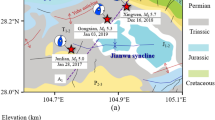Abstract
The main goal of the Fault Plain Solution (FPS) application is the determination of the faulting mechanism that characterizes earthquake parameters (dip, strike, rake). For this purpose, regional Moment Tensor Inversion (MTI) method that calculates faulting parameters using three-dimensional broad-band waveform seismic data was used. FPS application is composed of two main software components: the first one is Time Domain Moment Tensor Inverse Code (TDMT_INVC with synthetic seismogram calculation) and the second one is Seismic Data Server Application Service (SDSAS) that is used for retrieving waveform data from storage elements. The most time consuming part of the FPS application involves the calculation of Green’s functions. Therefore, we parallelized calculation of the Greens functions. A Job Description Language (JDL) workflow is automatically created based on the initial parameters of individual crustal models that are necessary for producing Green functions. Timing results obtained show that our FPS application did achieve speed-up as a result of parallelization.







Similar content being viewed by others
References
Clévédé E, Weissenbach D, Gotab B (2009) Distributed jobs on EGEE Grid infrastructure for an Earth science application: moment tensor computation at the centroid of an earthquake. Earth Sci Inform 2:97–106
Dreger DS (2002) Time-Domain Moment Ternsor Inverse Code (TDMT_INVC) Release 1.1, http://www.seismo.berkeley.edu/~dreger.
Dreger D, Romanowic BG, Clitheroe G, Hellweg P, Stevens J (2001) Development of automated moment tensor software at the prototype international data center. 23rd Seismic Research Review: Worldwide Monitoring of Nuclear Explosions. October 2–5, 2001.
Goldstein P (2008) Seismic analysis code SAC2000, lawrence Livermore National Laboratory. http://www-ep.es.llnl.gov/www-ep/esd/seismic/sac.html
Haskell NA (1964) Radiation pattern of surface waves from point sources in a multi-layered medium. Bull Seismol Soc Am 54(1):377–393
Herrmann RB, Wang CY (1985) A Comparison of synthetic seismograms. Bull Seismol Soc Am 75(1):41–56
Jost M, Herrmann RB (1989) A student’s guide to and review of moment tensors. Seismol Res Lett 60:37–57
Kikuchi M, Kanamori H (2003) Note on teleseismic body-wave inversion program, available http://www.eri.u-tokyo.ac.jp/ETAL/KIKUCH/manual.doc.
Lee WHK, Lahr JC (1972) HYPO71: a computer program for determining hypocenter, magnitude, and first motion pattern of local earthquakes. Open File Report, U. S. Geological Survey, 100pp.
Randall GE (1994) Efficient calculation of complete differential seismograms for laterally homogeneous earth models. Geophys J Int 118:245–254
Saikia CK (1994) Modified frequency-wavenumber algorithm for regional seismograms using Filon’s quadrature; modeling of Lg waves in eastern North America. Geophys J Int 118:142–158
Acknowledgements
This research is supported by the FP7-SEEGRID-SCI project under the grant number 211338. We also thank the TUBITAK-ULAKBIM personnel for their help and for making available the TR-GRID infrastructure
Author information
Authors and Affiliations
Corresponding author
Additional information
Communicated by Can Özturan
In this study “Moment tensors were computed using the mtpackagev1.1 package developed by Douglas Dreger of the Berkeley Seismological Laboratory, and Green’s functions were computed using the FKRPROG software developed by Chandan Saikia of URS.”
Rights and permissions
About this article
Cite this article
Yilmazer, M., Bektas, B. & Kozlovszky, M. Gridification of regional Fault Plain Solution (FPS). Earth Sci Inform 3, 239–245 (2010). https://doi.org/10.1007/s12145-010-0068-x
Received:
Accepted:
Published:
Issue Date:
DOI: https://doi.org/10.1007/s12145-010-0068-x




